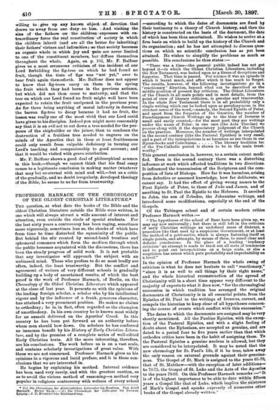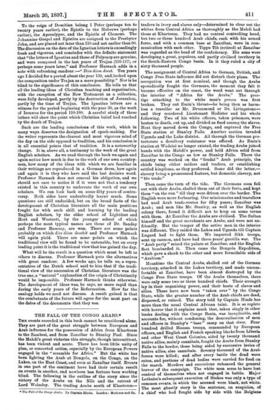PROFESSOR HARNACK ON THE CHRONOLOGY OF THE OLDEST CHRISTIAN LITERATURE.*
THE question, at what date the books of the Bible and the oldest Christian literature outside the Bible were written, is one which will always attract a wide amount of interest and attention, even outside the circle of special students. For the last sixty years a controversy has been raging, sometimes more vigorously, sometimes less so, the shocks of which have from time to time disturbed the equanimity of the public. But behind the stir created by second-band treatises and ephemeral romances which form the medium through which the public becomes acquainted with the discussions, there has been the steady progress of solid work. It is not probable that any investigator will approach the subject with an unbiassed mind. Those who profess to do so most loudly are often, indeed, the least trustworthy. But the conflict and agreement of writers of very different schools is gradually building up a body of ascertained results, of which the best proof is the work of Professor Harnack, of Berlin, on the Chronology of the Oldest Christian Literature which appeared at the close of last year. It presents us with the opinions of the leading foreign scholar, a scholar who by his intellectual vigour and by the influence of a frank, generous character, has attained a very prominent position. He makes no claims to orthodoxy ; he is, in fact, often regarded as the champion of unorthodoxy. In his own country he is known most widely for an assault delivered on the Apostles' Creed. In this country he has been put forward as an authority before whom men should bow down. On scholars be has conferred an immense benefit by his History of Early Christian Litera- ture, and by the promise of a complete series of well-edited Early Christian texts. All the more interesting, therefore, are his conclusions. The work before us is on a vast scale, and contains scholarly investigations of great value. With these we are not concerned. Professor Harnack gives us his opinions in a vigorous and lucid preface, and it is these con- clusions that we are interested in.
He begins by explaining his method. Internal evidence has been used very rarely, and with the greatest caution, so as to avoid the vicious method of reasoning—a method very popular in religious controversy with writers of every school
• (14 Die Chronologio der Altchristliehen Littoratur bis Busebius. Von Adolf
Barwick. Eroter Chronoloyis der Littoreur Us /mulls. Leipzig: J. 0..Binrichs'echc Buchhandlang.
.—according to which the dates of. documents are fixed by their testimony to a theory of Church history, and then the history is constructed on the basis of the document, the date of which has been thus ascertained.- He wishes to arrive at a firm basis on which to build up the history of the Church and its organisation; and he has not attempted to discuss ques- tions on which no scientific conclusion has as yet been attained. He wishes to simplify the problems as much as possible. His conclusions he thus states :—
"There was a time—the general public indeed has not got beyond it—in which the Oldest Christian Literature, including the New Testament, was looked upon as a tissue of deceptions and forgeries. That time is passed. For science it was an episode in which it learnt much, and after which it has much to• forget. The results, however, of the following investigations go in a `reactionary' direction, beyond what can be described as the middle position of present day criticism. The Oldest Literature of the Church in all main points and in most details, from the point of view of literary criticism, is genuine and trustworthy. In the whole New Testament there is in all probability only a single writing which can be looked upon as pseudonymous in the strictest sense of the word,—namely, the Second Epistle of Peter, and apart from the forgeries of the Gnostics, the number of Pseudonymous Church Writings up to the time of Irene3us is small and easily counted,—for the most part they are writings under the name of Peter : in one case (the Acta Theclae) we possess along with it the depreciatory judgment of the Church on the practice. Moreover, the number of writings interpolated in the second century (like the Pastoral Epistles) is very small, and a part of the interpolations is as harmless as are those in our
Hymn-books and Catechisms The literary tradition toc of the Pre-Catholic period is shown to be in the main trust- worthy."
This general conclusion is, however, to a certain extent modi- fied. Even in the second century there was a disturbing influence at work which affected traditions in two directions. It influenced the transmission of the Scriptures and the com- position of lists of Bishops. How far it was harmless, arising from defective or assumed knowledge, how far deliberate, we cannot say. It had the effect of giving wrong names to the First Epistle of Peter, to those of Jude and James, and of ascribing to St. Paul the Epistle to the Hebrews. It ascribed to John, the son of Zebedee, the Johannine writings, and introduced some modifications, especially at the end of the Gospels.
Of the Tubingen school and of certain modern critics Professor Harnack writes :-
" The hypotheses of the school of Baur have been given up, we may say now universally ; but there is still left in the criticism of early Christian writings an undefined sense of distrust, a procedure like that used by a suspicious Government, or at least the method of a petit-maitre, which is always fastening itself on single points, and attempts, by means of them, to assail clear and definite conclusions. In the place of a leading tendency criticism' an attempt is made to track out all sorts of tendencies and to point out interpolations on a large scale, or else a scepticism has arisen which puts probability and improbability on a level "
In the opinion of Professor Harnack the whole swing of criticism is what he does not hesitate to call "reactionary," " since it is as well to call things by their right name," and the whole historical reconstruction of the spread of Christianity will in a short time appear very different to the majority of experts to what it does now, " for the chronological succession in which tradition has arranged the original documents of Christianity is in all essential points, from the Epistles of St. Paul to the writings of Irenmus, correct, and compels the historian to keep clear of all hypotheses concern- ing the course of events which conflict with this succession."
The dates to which the documents are assigned may be very shortly mentioned. All the Pauline Epistles, with the excep- tion of the Pastoral Epistles, and with a slight feeling of doubt about the Ephesians, are accepted as genuine, and are dated to a period four to five years earlier than that which orthodox critics have been in the habit of assigning them. To the Pastoral Epistles a genuine nucleus is allowed, but they are considered to be interpolated. It may be noted that the new chronology for St. Paul's life, if it be true, takes away the only reason on external grounds against their genuine- ness. The Gospel of St. Mark is assigned to the years 65-70, that of St. Matthew—with the exception of later additions—. to 70-75, the Gospel of St. Luke and the Acts of the Apostles to the years 78-93. On this Professor Harnack remarks :—"It is of the highest importance to be able to date within fifteen years a Gospel like that of Luke, which implies the existence of Mark's Gospel and speaks expressly of numerous other books of the Gospel already written."
To the reign of Domitian belong 1 Peter (perhaps ten to twenty years earlier), the Epistle to the Hebrews (perhaps earlier), the Apocalypse, and the Epistle of Clement. The Johannine Gospel and Epistles are assigned to the Presbyter John, and are placed not later than 110 and not earlier than 80. The discussion on the date of the Ignatian letters is exceedingly fresh and vigorous, and concludes with the definite statement that "the letters of Ignatius and those of Polycarp are genuine, and were composed in the last years of Trajan (110-117), or perhaps some years later," and Professor Harnack adds in a note with refreshing candour :—" Dies diem docet. Ten years ago I decided for a period about the year 130, and:looked upon the composition under Trajan as a mere possibility." Nor is he blind to the significance of this conclusion. He tells us that all the leading ideas of Christian teaching and organisation, with the exception of the New Testament as a collection, were fully developed, partly by the destruction of Jerusalem, partly by the time of Trajan. The Ignatian letters are a witness for the period beginning with the year 30, as the work of Irenzeus for the period 110-180. A careful study of these letters will show the point which Christian belief had reached by the death of Trajan.
Such are the leading conclusions of this work, which in many ways deserves the designation of epoeh-making. For the writer represents the clearest and most vigorous mind of the day on the side opposed to tradition, and his conclusion is in all essential points that of tradition. It is a noteworthy change. It is, above all, a testimony to the work of the great English scholars. As we read through the book we again and again notice how much is due to the work of our own country. men, how many of the ideas with which we are familiar in their writings are reproduced in a German dress, how again and again it is they who have said the last decisive word. Professor Harnack does not conceal his obligation, and we should not care to notice it if it were not that a tendency existed in this country to underrate the work of our own scholars. We can look back on some fifty years of contro- versy. Both sides have undoubtedly learnt much. Some questions are still undecided, but on the broad facts of the development of Christian literature all the main positions fought for with such skill and learning by the leading English scholars, by the older school of Lightfoot and Hort and Westcott, by the younger school of which perhaps the most typical names are those of Dr. Sanday and Professor Ramsay, are won. There are some points probably on which dies diem docebit and Professor Harnack will again yield. There are some points on which the traditional view will be found to be untenable, but on every leading point it is the traditional view that has gained the day.
What will be the result is a question which must be left to others to discuss. Professor Harnack puts the alternatives with great candour. A few weeks ago, he tells us, a repre- sentative of the Dutch school said to him that if the tradi- tional view of the succession of Christian literature was the true one, a "natural" explanation of the origin of Christianity would be impossible. Professor Harnack thinks otherwise. The development of ideas was, he says, no more rapid than during the early years of the Reformation. How far the analogy holds we need not discuss. A result gained is that the combatants of the future will agree for the most part on the dates of the documents that they use.







































 Previous page
Previous page